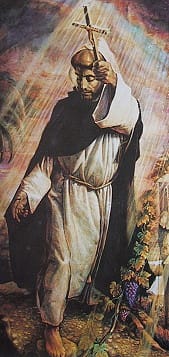Bridging Worlds: Giordano Ansalone's Dangerous Mission to 17th-Century Japan
Ansalone, a Dominican friar, risked it all to serve hidden Christians in Japan. Disguised as a Buddhist monk, he navigated a world of danger and cultural divide.

This article is about Giordano di San Stefano Ansalone, a 17th-century Italian Dominican missionary who became a martyr in Japan. If you're interested in learning about an intrepid explorer of faith during a tumultuous period of global exploration and religious conflict, read on. If not, feel free to skip it.

Early Life and Context
Giordano Ansalone was born in 1598 in Sicily, Italy, just a few years after Shakespeare wrote "Romeo and Juliet." The telescope had just been invented, and Galileo was about to make waves by suggesting the Earth revolved around the Sun - an idea that would get him in trouble with the Catholic Church.
The world of Ansalone's time was divided among a few major powers. Spain and Portugal were the dominant naval forces, with vast colonial empires. The Ottoman Empire controlled much of the Middle East and North Africa. In Asia, China's Ming Dynasty and Japan's Tokugawa Shogunate were powerful but increasingly wary of European influence.
Journey to the East
Ansalone joined the Dominican Order, a group of Catholic friars known for their commitment to preaching and education. After studying in Spain, he set off on an epic journey in 1625, traveling from Italy to Spain, then across the Atlantic to Mexico, and finally across the Pacific to the Philippines. This journey, fraught with dangers like storms, disease, and the unknown, could have taken years to complete.
In the Philippines, Ansalone did something remarkable for his time - he learned Chinese and Japanese and studied their cultures and beliefs. This wasn't just about converting people; Ansalone was genuinely interested in understanding different ways of thinking.
The Perilous Mission to Japan
In 1631, Ansalone volunteered for what was arguably the most dangerous mission a Catholic priest could undertake at the time - going to Japan. The country had recently closed its borders to foreigners and was violently persecuting Christians. This policy, known as Sakoku, was implemented partly due to the Shogunate's fear that European powers might use Christianity to colonize Japan, as they had done in other parts of Asia.
Why would Ansalone choose such a perilous path? Perhaps it was a combination of religious zeal and a genuine desire to help the hidden Christian communities in Japan. Or maybe, having studied Japanese culture, he felt a special connection to the country and its people. Whatever his reasons, Ansalone knew the risks and went anyway, disguising himself as a Buddhist monk to avoid detection.
Final Days and Legacy
For three years, Ansalone traveled across Japan in secret, ministering to hidden Christian communities. It was a life of constant danger and hardship. Finally, in 1634, he was captured. After enduring torture, Ansalone was executed by being buried upside down - a particularly cruel method designed to prolong suffering.
Ansalone's story is one of courage, curiosity, and conviction. In an age of religious intolerance, he sought to understand those who were different from him. In a time of limited global knowledge, he traveled to the far side of the world. And in the face of persecution, he remained true to his beliefs.
Today, Ansalone is remembered on November 17th as a saint by the Catholic Church, a symbol of faith and intercultural understanding. His life reminds us of the complex history of global exploration and religious conflict, and the individuals who navigated these turbulent waters with bravery and compassion.
Abandoning here,
Bradley
